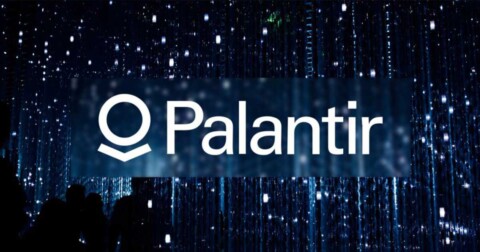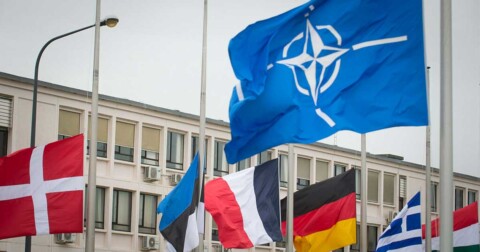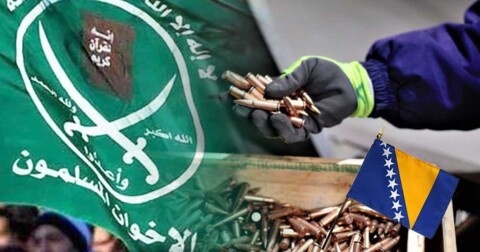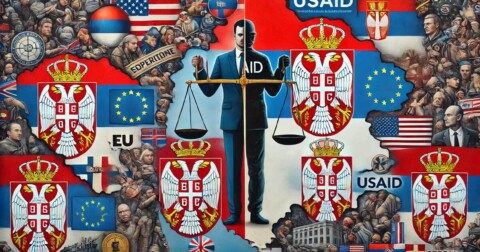The mystery surrounding the blockers and plenary members, who have been paralyzing the country for months, pushing it toward the brink of civil war, still awaits to be unraveled. When it comes to their organization, two important questions arise — who and how? Non-governmental organizations (NGOs) and individuals associated with them have often been the focus of our investigations. The analyses were thorough, but insufficient to explain the phenomenon related to the functioning models of blockades and plenums, and the way ideas are unanimously adopted and flawlessly executed. It is hard to shake the impression that the perfection with which directives from above are carried out is not merely a matter of diligence and responsibility of players at the operational level. There must be a scheme behind it.
THE MYSTERIOUS AUTHOR OF THE DEMAND
An email reveals it. Despite attempts to keep it the best-guarded secret, the author of this article obtained an email suggesting that the topics debated at plenums are not generated internally but directed externally. Each faculty under blockade has its own email address, controlled by a group of dedicated, highly active plenary members, known to other students. That fact is common knowledge. What draws attention is who the author of the correspondence is, and who owns the email address from which proposals for actions, blockades, and debate topics are sent. There is no doubt that there are guardians of this secret and that their number is small. Nevertheless, the directives are accepted and implemented without question. For months. And no one sees anything wrong or suspicious in it.
The goal is hard to discern since it changes daily, increasingly resembling the guidelines of the “Serbia Against Violence” coalition. Besides sharing objectives with the pro-Western opposition and NGO sector, which initiated this “flower revolution” as they currently call it, the slogans, style of communication, and mechanisms used are strikingly similar — including the demand for European institutions to intervene in Serbia.
For these purposes, some traveled by plane to distant European destinations, while students, presumably to invoke sacrifice and awaken emotions, opted to go by bicycle. Next in line are those who will repeat the feat by running, all in the hope that the international community will intervene — not in Kosovo and Metohija to free Serbs languishing for years in Albanian prisons without cause other than ethnicity — but to strip Serbia’s central sovereignty and impose a colonial status. But they are unaware of this. They merely follow the directives from the mysterious email, the alpha and omega of the blockades.
LET A THOUSAND FIRES BURN
Several months ago, when what we see today was unimaginable, one of the known plenary members — a child raised on European funds from an NGO family, Pavle Cicvarić — wrote: “Let a thousand fires burn, so they don’t know which one to extinguish first.” In the meantime, a thousand fires have indeed ignited, and one has been burning since April 14 in front of the RTS buildings in Takovska Street and Košutnjak in Belgrade, as well as in front of RTV in Novi Sad. Allegedly, the reason for these blockades is that rebellious students, who generally don’t watch RTS, realized that this national broadcaster was not covering their blockades, protests, and aimless walks across Serbia — nor their trip to Strasbourg.
The implausibility of this claim is evident given that students blocked RTS buildings on April 14, while they arrived in Strasbourg on April 15.
Even if there had been a willingness to report on their humiliating arrival in Strasbourg — where they were greeted by a Croatian MP, an organized and paid group of Serbs from Serbia, a few from the diaspora, and migrants, including Albanians from Kosovo — it would not have been possible because the blockades themselves became the top news. Perhaps that was the plan all along?

RTS IN THE FOREGROUND, STRASBOURG SECOND
Interestingly, media outlets supporting the blockaders, like N1 and Nova S, dedicated more coverage to the blockades than to the students’ arrival in Strasbourg. Even more interestingly, these media — supportive of every action against the government and the state — participated not as objective reporters but as active propagandists. They arrived at blockade sites simultaneously with the blockaders.
This time, another proposal plan arrived from the mysterious email, unanimously adopted. It corresponded with the demands of the “Serbia Against Violence” coalition and concerned pro-Western media outlets that first accused REM of not functioning according to its mission and of being politically influenced. These media houses did not receive the promised national frequency. However, assuming this was merely an act of revenge would be naive.
It’s striking that these “justice pursuers” found no fault with REM’s work when multiple reality shows — tasteless by every measure — were broadcasted, nor with the generally vulgar national television content that does not meet program requirements. Only when they didn’t get a national frequency did REM suddenly become problematic. During the “Serbia Against Violence” pre-election campaign, coalition leaders, exploiting others’ grief, kept changing protest reasons. Somewhere between bathing in a children’s pool in front of the Parliament and mourning the tragically deceased children from Ribnikar, yet another protest reason appeared — Nova S had not obtained a national frequency.
STAGED BY MEDIA MAGNATES
Now, these same demands, at incredible speed, became “student demands.” The same language, the same scenario, identical slogans. The only change: the mysterious sender hiding his identity to preserve organizational structure. Instead of direct attacks from the opposition and NGOs, the attacks now come through “spontaneous” plenums and blockades, with wholehearted support from “wronged” media outlets.
When all the pieces fit together, the true picture emerges: The destruction of REM is not a student demand but a directive from the same headquarters and centers located outside Serbia. Unfortunately, the students are unaware that they are pawns in a game orchestrated by media moguls and foreign political mentors, aiming for complete control over Serbia’s media space.
CHANGE IN OWNERSHIP STRUCTURE OF UNITED MEDIA
Interestingly, at the beginning of the year, the ownership structure of United Media changed. Some cable programs, like sports and entertainment channels, were bought by Dragan Šolak’s group — e& Group, a state telecom company from the UAE — in collaboration with the Czech investment conglomerate PPF Group. However, main propaganda channels like N1 and Nova S remained in Šolak’s hands.
Although this media magnate promised to retain the editorial policy and avoid layoffs, he sold the most profitable channels. This does not mean he abandoned his primary goal — obtaining a national frequency and influencing Serbia’s entire media scene via REM. Negotiations over the distribution of N1 and Nova S channels are not merely market-based but about controlling the media narrative in Serbia because whoever controls the media controls everything else.
While SBB, under foreign ownership, often tries to portray Serbia as unstable, Telekom, as a national company, has a duty to protect the media space from foreign dominance and politically biased journalism. In this case, Telekom’s decisions to promote domestic, objective, and nation-building content — while limiting those working against Serbia’s interests — should not be seen as censorship, but as legitimate defense of national media space.

THE BATTLE FOR MEDIA
When framed like this, it’s clear: blocking RTS is not the ultimate goal of those instructing the students.
Adding the fact that even the ruling regime is dissatisfied with RTS’s reporting, frequently criticizing it for stepping outside the national narrative, the true target of this “flower revolution” becomes apparent — REM. Whoever controls REM will not only decide who gets national frequencies but will gain access to a much broader audience and impose a desired media reality. Thus, the demands to dissolve REM are synchronized with the demands of the “Serbia Against Violence” protests and those pushed for years by media under Dragan Šolak and United Media’s umbrella.
The mechanism is transparent to those willing to see:
- Students are sent instructions via an anonymous email, clearly prepared by media and NGO centers.
- REM is portrayed as the priority issue in Serbia (!?), although the average student hardly knows what REM does.
- RTS blockades serve as spectacles meant to produce a picture of mass dissatisfaction and create a pretext for radical changes in regulatory bodies.
- Behind it all are the interests of media structures that failed to obtain national frequencies legally.
INFANTRY TOWARD COLONIZATION
This is not a battle for democracy but a fight for monopoly over truth.
In this plan, students are merely infantry — an emotional shield for the interests of those who never protect the Serbian people but only their own business and political agendas.
The endgame is simple: dissolve the current REM, install new members close to NGOs and pro-Western media, secure national frequencies for outlets like Nova S and N1, and thereby take over Serbia’s entire information space.
RTS is not the goal but just a temporary stop on the road to full media colonialism.
What kind of future, then, do students offer, students who unquestioningly execute directives from an anonymous email, accepting rules under which the author remains unknown — allegedly for the “protection of organizational security”.





